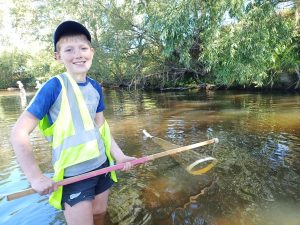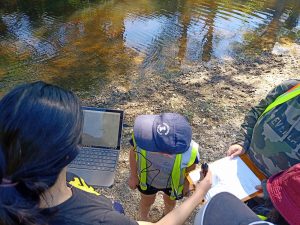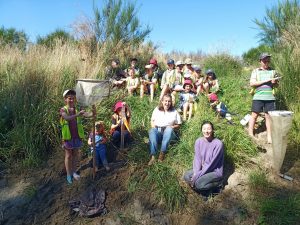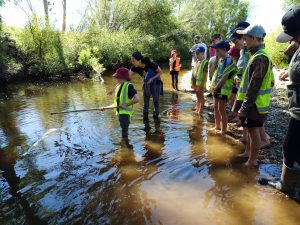Microplastics in the curriculum
In early May of this year Christine Liang from the Southern Institute of Technology (S.I.T.) and I caught up to discuss the feasibility of working in partnership on Christine’s microplastic project. Many teachers around the country develop term plans with a focus on connecting with their local awa. These studies often result in positive changes to water catchments and an increased community awareness of the plight of our rivers and waterways.

Young people learn sampling skills and add information to a database.
With this in mind, we developed a plan for how schools could join us to collect samples from their local waterways. This data would then be analysed back at S.I. T’s lab with the support of Christine’s first and second year Environmental Management students. Our overall aim was to raise awareness about microplastics in rivers, to involve all sections of education and to make change for the sustainability and life of the waterways. Empowering tamariki, no matter what level of their studies or skill set was a key driver in this project.
Once the plan was developed we spent the next three months working with school groups collecting data, creating curriculum links and running whole school presentations to ensure we had school and community buy in. The feedback and support to date has been phenomenal with a number of media outlets publishing articles on our project. Christine has also been successful in securing grant funding which has been a welcomed boost to the work that is being achieved on the ground.
The statement ‘it is hard to care for something that you cannot see’ rings true in the case for micro plastics. We are often studying and analysing particles that are smaller than 5mm. To put this project into perspective these particles have not only been found in our kai and waterways but in some of the most remote locations on Earth such as Mount Everest and Antarctica.
As mentioned by Christine these participles are so small “They are literally in the air we breathe,” which has resulted in the average human consuming approximately 52,000 micro particles per year.
Te whāinga (the goal)

Christine has a laptop and microscope in the field, allowing students to actually see the microplastics.
To enable school groups to participate in this project the approach needed to be simple in design and practice. The procedure itself requires one plankton net to be placed in the river for half an hour; this is then analysed using chemicals often found in school chemistry labs. This standardised approach links well to citizen science, whereby we are empowering communities to share and contribute to data monitoring and the collection process.
In order for the stream study to become more impactful for students Christine often takes along a laptop and microscope, allowing students to actually see the microplastics. This simple act can often be very powerful as students begin to build a picture of what types of plastics are entering our water ways and develop a curiosity as to where it will eventually end up.
Community Links

Christine Liang from S.I.T works with a group of students on the banks for their awa to measure microplastics and assess waterway health.
As a way to showcase all of this amazing mahi going on around Southland, staff from S.I.T organised a micro investigators hui. The workshop gave school groups that participated in the data collection a chance to discuss and share some of their results from their stream studies. Students also had the opportunity to identify some alternative uses of plastic and work together to think about how we can overcome this major pollutant.
The hui was also the perfect opportunity to launch the brand new micro investigators website. The website displays the data collected by students and pin points where the stream study was carried out. The website could also be viewed as a milestone for the project, as it has been months in the development with numerous organisations and people involved to ensure its success. Long term it is hoped it will become a repository of data, with the possibility to compare and monitor the state of microplastics in our waterways throughout Southland. Overall it is a fantastic example of community groups working towards a common goal.
One delightful outcome of student engagement has been a video created by Sophie Ineson of Southland Girls’ High School (and submitted to Keep New Zealand Beautiful Young Reporters for the Environment Competition), which outlines the Micro-Investigators: monitoring of waterway microplastic pollution in Southland project and how people can get involved through Citizen Science. (unfortunately, no-longer available).
Te ara (future outlook)

Christine makes sure students use a standardised approach to collect samples holding the plankton net in the river for half an hour. (Banner image)
The future of this microplastic monitoring project looks bright, with Christine now ready to hand it over to her S.I.T students, allowing them to develop the programme and continue to reach out to as many Southland schools as possible. This citizen science approach has allowed students from diverse backgrounds to explore this programme in a fun and interactive manner.
It is our vision that it can one day be rolled out nationally and for all students and community groups to take part in this important mahi. In time we would love to see students teaching their whole whānau and encouraging them to take action as a result.
“Poipoia te kakano, kia puawai – Nurture the seed and it will blossom.”
